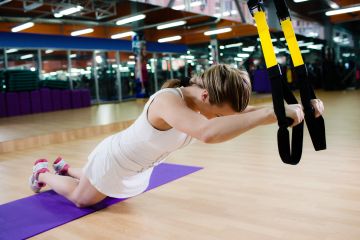The Secret Exercise All Women and Men Need to Learn
When your trainer mentions one’s pelvic floor, some people may feel awkward about it, particularly men. But, here’s a revelation: the pelvic floor plays a major role in health, hygiene, spinal stabilisation and sexuality–for women and men. This is all too often neglected in exercise programs, especially for those people who suffer from weakness in the area.
 The pelvic floor plays a significant role in spinal stabilisation, which can result in more effective workouts, particularly strength. With a better understand of what can strengthen and weaken our pelvic floors, we’ll be able to operate more effectively in our daily lives.
The pelvic floor plays a significant role in spinal stabilisation, which can result in more effective workouts, particularly strength. With a better understand of what can strengthen and weaken our pelvic floors, we’ll be able to operate more effectively in our daily lives.
The pelvic floor or PF is a group of muscles that form a sling-like support for the bowel, bladder, and in females, the uterus. Other muscles in this area include the external anal sphincter muscle and the superficial perineals. The role of the pelvic floor is to support the pelvic organs, assist with increases in intra-abdominal pressure and spinal stabilisation, assist bladder and bowel control, contribute to sexual arousal and performance. Essentially, the pelvic floor muscles are between your pubic and tail bones, and control your bladder.
A stressed or weak pelvic floor often occurs in post-natal women, but anyone can experience this loss of control. During workouts, the stresses or weakness of one’s pelvic floor can be reflected. If a woman has issues with bladder or bowel control, running and lifting could exacerbate those problems even further. Trainer and client alike should pay careful attention to pelvic floor health. Otherwise, neglect can lead to more serious conditions, like a bladder prolapse.
The pelvic floor is actually an endurance muscle. Contractions are used to train the pelvic floor and can be done a number of ways, from sitting to standing to lying down as well as during movement. A great way to ease into pelvic floor exercises is through weight training or simple core exercises, which are great for spinal health.
According to professional physical therapists and fitness experts, the correct way to initiate the pelvic floor is to slowly lift the muscles, ideally starting at the tail bone and moving through the pubic bone. Many may find it even easier to lift the group of muscles as one. Simply put, lift the muscle as though you are trying to control your bladder.
It’s important to breathe normally throughout the process, while maintaining a relaxed posture. The thighs and buttocks must also not be squeezed. The latter is easier to prevent by leaning forward while sitting or kneeling.
When lifting the pelvic floor, both front and back, aim to hold it over three counts. Hold the contraction at the top for 10 counts, while breathing normally. Repeat this twice, gradually increasing the hold time.
Another method is to lift the lower pelvic floor quickly, making them short and strong. Ten strong contractions is a good start.
You can combine the two techniques by first lifting slowly and then adding 10 pulses at the top before relaxing.
Ideally, one should exercise one’s pelvic floor daily.





